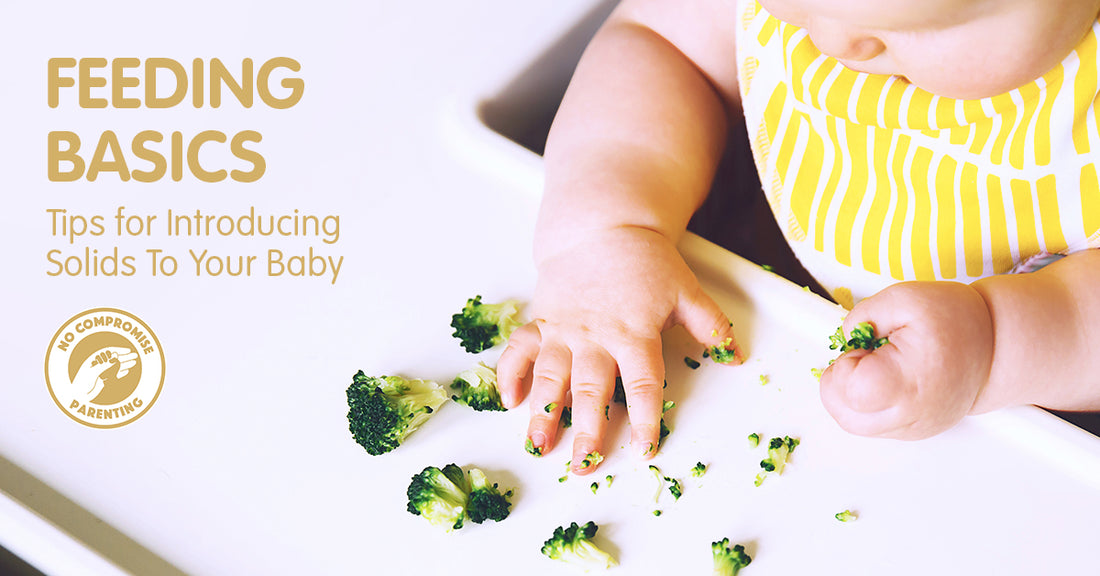Has your baby's doctor said it's almost time to begin your little one on solids? Weaning your baby off the breast and introducing solid foods is one of the biggest milestones in your baby's first year!
There are numerous ways to wean your baby that are totally different – so it may be confounding to make sense of which one is the right one for your infant. But there's not only one "right" approach to introduce solid foods, and each baby is unique!
How to Know If the Baby Is Ready for Solid Foods?
One of the main concerns new mothers have about introducing solids is "When" they should start. Pediatricians can likewise complicate this answer by saying "somewhere in the range of four and six months."
The American Academy of Pediatrics suggests six months a decent age to begin introducing solids.

In addition to age, look for different signs to know if your infant is ready for solids, such as:
- Can your infant hold their head in a consistent, upstanding position?
- Can your infant sit with help?
- Is your infant mouthing their hands or toys?
- Is your infant reaching out for your food?
If your answer is yes to these inquiries and your infant's doctor concurs, you can start supplementing your child's feeding routine.
Tips for Introducing Solids
Which Solid Foods Should You Feed Your Baby First?
Start simple by offering single-ingredient foods that contain no sugar or salt. Hold up three to five days between each new food to check whether your infant has a reaction, for example, diarrhea, a rash, or heaving.

Other tips from healthychildren.org to keep in mind when starting solids:
- There is no evidence that waiting to introduce baby-safe (soft) foods, such as eggs, dairy, soy, peanut products, or fish, beyond 4 to 6 months of age prevents food allergy. However, testing for peanut allergy is recommended for babies with severe eczema and/or egg allergy. Check with your child's doctor about how and when to give peanut products.
- There is no evidence that your baby will develop a dislike for vegetables if fruit is given first.
- Be sure to include foods that provide iron and zinc, such as baby food made with meat or iron-fortified cereals.
- If you feed your baby premade cereal, make sure it is made for babies and is iron fortified. Baby cereals are available premixed in individual containers or dry, to which you can add breast milk, formula, or water.
At this point, you're simply getting your baby used to new nourishments, textures, and foods. Try not to panic if she isn't eating a ton from the start. Most of the eating is only for play and to become accustomed to the experience.
Preparing Baby’s Food
Some foods are potential choking hazards, so it is important to feed your child foods that are the right texture for his or her development. To help prevent choking, prepare foods that can be easily dissolved with saliva and do not require chewing. Feed small portions and encourage your baby to eat slowly. Always watch your child while he or she is eating.
- Mix cereals and mashed cooked grains with breast milk, formula, or water to make it smooth and easy for your baby to swallow.
- Mash or puree vegetables, fruits and other foods until they are smooth.
- Hard fruits and vegetables, like apples and carrots usually need to be cooked so they can be easily mashed or pureed.
- Cook food until it is soft enough to easily mash with a fork.
- Remove all fat, skin, and bones from poultry, meat, and fish, before cooking.
- Remove seeds and hard pits from fruit and then cut the fruit into small pieces.
- Cut soft food into small pieces or thin slices
- Cut cylindrical foods like hot dogs, sausage and string cheese into short thin strips instead of round pieces that could get stuck in the airway.
- Cut small spherical foods like grapes, cherries, berries and tomatoes into small pieces.
- Cook and finely grind or mash whole-grain kernels of wheat, barley, rice, and other grains.
Source: https://www.cdc.gov/
Remember moms, fresh produce can become contaminated in many ways so make sure to wash your fruits and veggies thoroughly for your baby’s safety! Always use a natural-based cleanser that’s certified natural, non-toxic, and edible.

Encouraging Good Eating Habits from an Early Age
It is significant for your child to become acclimated to the way toward eating—sitting up, taking food from a spoon, resting among chomps, and halting when full. These early encounters will enable your kid to learn great dietary patterns all through life.
At long last, make the most of your infant's messy plate, gooey hands, and clingy face. You're fabricating the establishment for a lifetime of healthy eating!
Related article: Why Should You Use Natural Products For Your Baby

